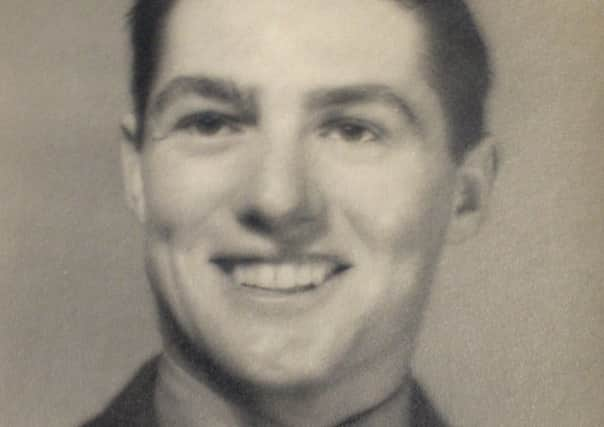Obituary: Patrick Dorehill, DSO DFC and Bar, aviator


Patrick Dorehill was to live to be the last survivor of the ill-fated Augsburg Raid of 17 April 1942, in which nearly half the men who set off in new Lancaster bombers to attack a Bavarian factory by daylight were killed.
Aged 20 at the time, the tall, elegant Rhodesian-born Dorehill was co-pilot with Squadron Leader John Nettleton, VC, in Lancaster “B-Baker”, and from his fold-up seat at Nettleton’s side, was to give a vivid account of the disaster that befell the crews from 44 and 97 Squadrons RAF.
Advertisement
Hide AdAdvertisement
Hide AdDorehill’s excitement, and faith in the capabilities of the new bomber, with its wingspan of more than 100ft and armament of eight Browning .303 machine guns, came down to him right from the RAF’s top brass. The mission, Operation Margin, had been meticulously planned.
His squadron, No 44, based at RAF Waddington in Lincolnshire, had been the first to receive the new aircraft that February, and he had carried out mine-laying operations in it, as well as a fortnight’s low-flying practice.
Dorehill, Nettleton, and the other five crew, together with the rest of the force of 12 Lancs, crossing the French coast at 4.45 in the afternoon, were to skim treetops, to avoid detection and anti-aircraft fire, all the way across occupied France, through Switzerland, and on deep into Hitler’s Reich to bomb the Maschinenfabrik Augsburg-Nurnberg at Augsburg, which made diesel engines for U-boats.
A diversionary “circus” of Spitfires was to engage the Luftwaffe over northern France, and so the Lancasters’ 800-mile flight would surely be, Dorehill thought, a piece of cake.
But the “circus” took place 40 minutes too early – and the pilots of German FW 190 and Me 109 fighters, returning to base at Beaumont-le-Roger, south-west of Rouen, saw the leading Lancasters, 44 Sqn’s, and went for them. Within minutes three were shot down – and, Dorehill recalled,”our feelings changed.”
The fourth Lancaster to crash only just missed B-Baker on its way down. “We could see the flames in the cockpit”, Dorehill said – flashing by so close that he flinched.
Dorehill and Nettleton decided to continue, even though they could have escaped south. Three more Lancasters, one from 44 Sqn and two from 97 Sqn following some way behind, were to be lost to anti-aircraft fire over Augsburg – but B-Baker dropped her bombs, and hit true, shattering the factory’s roof.
Of those who had set out from Waddington, B-Baker’s crew alone returned home, though they strayed, and had to land 160 miles away at Blackpool. Four aircraft of 97 Sqn got back to their Woodhall Spa base. Dorehill was awarded a DFC, and Nettleton the VC.
Advertisement
Hide AdAdvertisement
Hide AdRAF chiefs took stock- and, the following year, when the “Dambusters” bombed the Ruhr dams, they flew at night, daylight being deemed too risky.
Dorehill now got his own Lancaster, and in 1944 won a Bar to his DFC when he, like Nettleton, continued to his target even after a fighter attack that damaged his fuselage, tailplane, and hydraulic system. “On return to base he effected a masterly crash-landing,” the citation says.
Dorehill married a Lincolnshire girl, Pauline Gamble. The couple remembered parties filled with friends, who by the next gathering were missing, killed. They were to have two daughters and two sons, Pippa, Stella, Andrew and Daniel.
In September 1944, now in the rank of Flight Lieutenant, Dorehill was awarded the DSO for his achievements during some 60 operational sorties, including seven attacks on Berlin. He became an instructor, and later transferred from Bomber to Transport Command.
After the war, in 1946, he joined Imperial Airways, and was to take part, flying a Vickers Viking, in the 1948 Berlin Airlift.
An only child, who throughout his life loved epic adventure such as Homer’s Iliad, Patrick Arthur Dorehill was born in Fort Victoria, Southern Rhodesia (now Zimbabwe). His father was a Rhodesian government district official in a remote mining area, and the boy was educated at Michaelhouse School, Natal, South Africa.
He went to university and seemed destined for an engineering career in Rhodesia’s mines, when war broke out, offering what to him appeared exciting opportunities in Britain. Having done some flying training in Rhodesia, he joined the RAF Volunteer Reserve as a sergeant in 1941.
After the war Imperial Airways divided into the British Overseas Airways Corporation (BOAC) and British European Airways (BEA); later it became British Airways.
Advertisement
Hide AdAdvertisement
Hide AdDorehill chose BEA and rose to be a senior captain, flying jet aircraft, and retiring in 1976. He and his family lived in Lincolnshire, then Buckinghamshire. Pauline died in 1978; he was to outlive a second wife, Dora; later he would be married for 27 years to Hazel Payton, who survives him, and with whom he made his home at Crowborough, East Sussex.
In retirement he became a keen golfer, and was noted for achieving a hole in one at the age of 91.
Not one to dwell on the war, he always remembered, nevertheless, a chance meeting at Vienna international airport in 1948 with a fellow civilian captain, an Austrian, who revealed he held a wartime Iron Cross for his prowess in shooting down two Lancasters on April 17 1942: “We had actually opposed each other that very afternoon.”